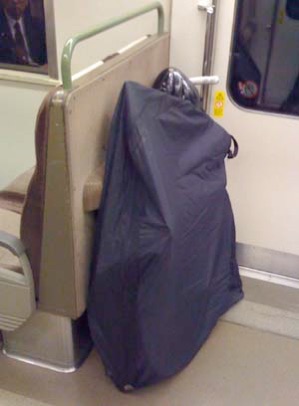Using Bikebags
A bikebag ("rinko-bukuro" in Japanese) can be purchased at any bicycle shop. I used to like a brand called Ostrich made by Azuma Sangyo; the most inexpensive one ("Emu") went for about 5,700 yen; a "road" version cost 6,700 yen and has pockets for the wheels. There are also "deluxe" models, usually larger sized, with prices to match. Recently, cheaper brands have come out; the Tioga brand sells for around 4,000 yen or less. This bag might be a tiny bit smaller than the others, but not enough to matter.
Recently the popularity of tiny folding bikes seems to have pushed the market toward smaller bags, and some lighter and smaller bags have appeared, including the ultra-light Tioga Cocoon for 3,780 yen and an even smaller one for 6,800 yen, shown below at left and right respectively:



Using a bikebag couldn't be simpler. Just remove the wheels from the bicycle, stick both frame and wheels in the bag (with the wheels on either side of the frame) and zip it up. The bag comes with a bracket to hold your derailleur in place (to protect it from damage, since it’ll be on the bottom) and instructions that tell you to remove the seat, pedals and, in some cases, the handlebars. But remember, we're not following the rule that says the bike has to fit entirely inside the bag. Therefore in most cases you won't have to remove anything except the wheels. I've never had ANY station personnel complain about the fact that, say, the handlebars are sticking out of the bag. I've also never used the bracket - and never suffered any derailleur damage. (However, I’m always extremely careful to set down and lift the bag very gently, and I recommend that you do the same.)
Eliminating the need to remove anything but the wheels and the need to attach the derailleur bracket reduces bagging time dramatically; I've clocked myself at 3 minutes from the time I wheeled up to the station until the time I was actually walking through the wickets with the bike bag slung over my shoulder. That's including the time it takes to don gloves for the messy bagging procedure. (Note that this is only possible when you’re firing on all cylinders; five minutes is a more realistic amount of time under real-world conditions.)
Since the bikebag is only for appearances, it follows that you can extend its life by not using it to bear the full weight of the bike. Tie a strap around the frame and carry the bike by that strap; your bag will last much longer. Another way to extend its life is to avoid using laundry detergent or other abrasive soaps when you wash the bag; it's the only thing that seems to seriously damage them. Use warm water and a mild soap of some kind. And, getting back to the guy with the clothespins, you COULD save a bit of money by using a similar workaround instead of buying a real bikebag... but it seems hardly worth the effort. The bikebags available in Japan are relatively inexpensive, and they are tough as iron and will last for years with proper care (as long as you keep them away from that laundry detergent...).
In the past, you were required to buy a "mimawarihin-kippu" (a ticket for large packages) if you have a bagged bike. This is inexpensive (currently 280 yen) and seems to be good for the entire day; an express train conductor once told me it was only good for a single train, but he was the only one. However, these days, the station personnel don't even ask to see the bikebag ticket when you enter and exit the wickets at the station, so most of the time you can get away without buying one (automated wickets may help here; generally you're through them so fast they don't bother to stop you). I haven’t been asked to buy one for years. However, it’s still possible that you might be asked to buy one, and it seems that a lot of cyclists get angry about that. When you think about it, 280 yen to take your bike anywhere in Japan is not a bad price at all - and this system is what makes it possible for you to see far-off places by bicycle. So if someone asks you to buy a ticket for your bike, I'd recommend that you smile and do so willingly.
On most trains, there is enough space just inside the doors to place the bag without inconveniencing other passengers (as shown in the photo above). I recommend that you use the carry strap to tie the bike to the handrail to prevent it from falling over; just be sure to give yourself enough time to get it loose before you arrive at your destination. As always, be careful when you set the bag down to avoid derailleur damage. And try to avoid rush-hour trains; those news reports you've seen about people being crammed into trains are all too true.
(Note: For more information, see our Feature on recent bikebag trends.)

































